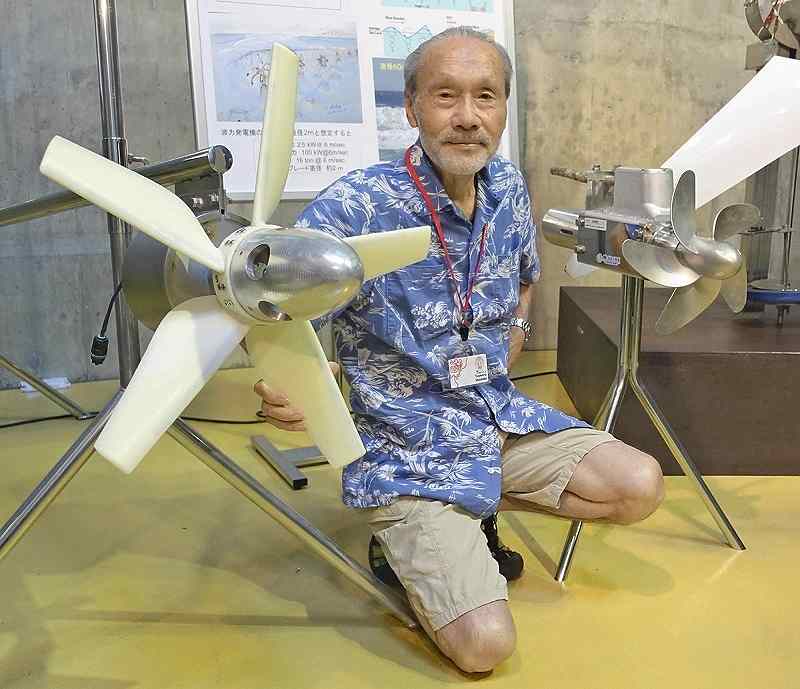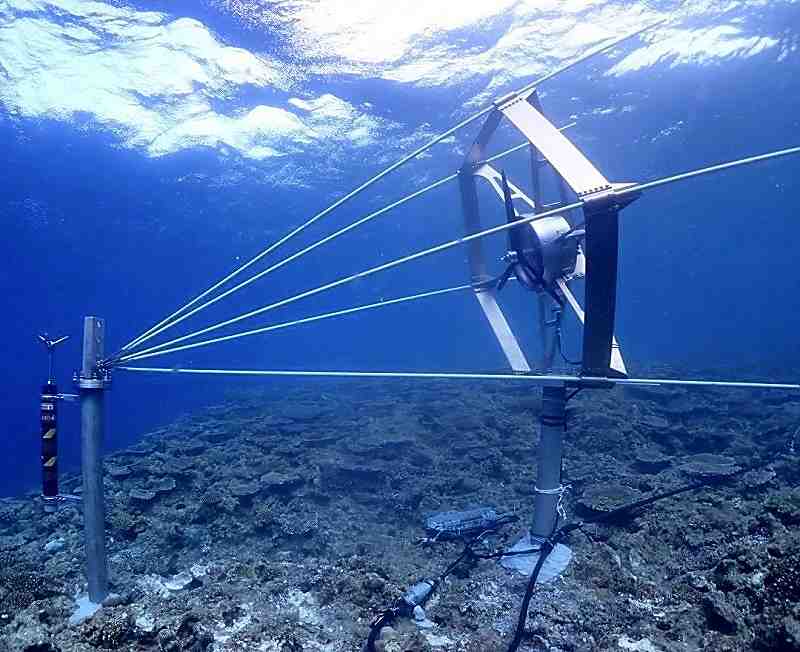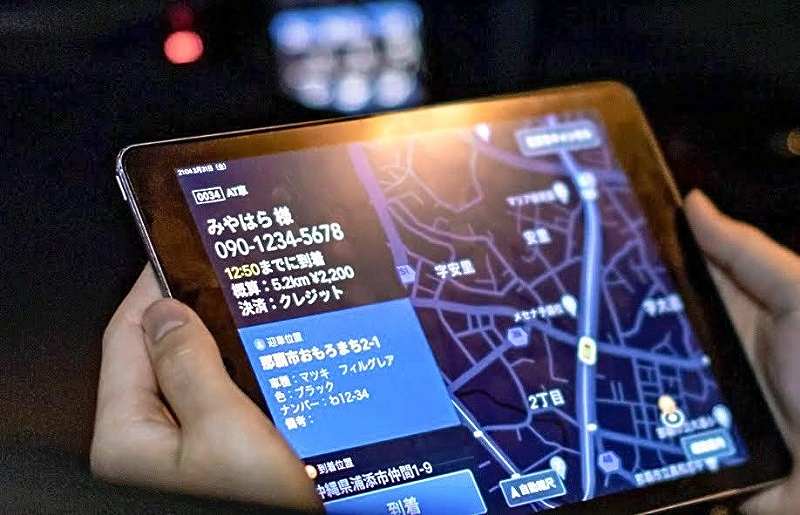
Prof. Tsumoru Shintake shows parts of a wave power unit in Onna, Okinawa Prefecture.
The Yomiuri Shimbun
13:22 JST, May 17, 2022
As large-scale resort hotels line the beaches of Onna, a village in the central part of Okinawa Island, just below the surface of the ocean about 100 meters offshore lies a unique object that is hoped to also boost the local economy.
A metal propeller is part of an electricity generating unit that makes use of waves to rotate the turbine.
As long as there are waves, the unit can generate electricity day or night, making it more stable than systems based on wind or solar energy.
Wave power has the potential to be a renewable energy source suitable for Japan, which is completely surrounded by the sea.
“By generating electric power in the Sea of Japan 24 hours a day, this can be a core electricity source in winter when demand for energy rises,” said Prof. Tsumoru Shintake, a researcher of accelerator science who installed the unit off Okinawa.
There are hurdles to clear before the units can be put into practical use as Shintake envisions, such as the huge amount of initial investment required.
Shintake belongs to the Okinawa Institute of Science and Technology Graduate University (OIST), which opened in Onna in 2012 as part of government-led measures to stimulate the economy in Okinawa Prefecture. The government aims to make the OIST one of the world’s highest-level research bases.
The OIST is a five-year graduate school with doctoral courses only. Foreign nationals account for 42% of the 1,048 faculty members and other officials as of April, and 82% of the 255 students as of January. English is the common language used in teaching and research activities.
Though the OIST’s history is short, in 2019 it was ranked ninth in the world among research institutes with high percentages of advanced academic reports in natural science. That was the highest among Japanese research institutions, thus the OIST has been drawing attention.
During preparations to open the university, Shintake was approached by Jonathan Dorfan, who served as OIST’s first president. At the time, Shintake was set to be a professor at Stanford University, but Dorfan enthusiastically convinced him to accept the OIST offer.
As researchers in some of the most advanced fields gather at the OIST, it may seem like a different world to many residents in the prefecture. But relations between the university and local communities have been gradually deepening.
BioAlchemy, a startup based in Onna, was established based on OIST research. The company manufactures wastewater treatment equipment that uses bacteria to purify the water.
“I want to know the needs in local communities and connect them to our business,” said BioAlchemy’s 49-year-old CEO, Tomoharu Inoue.

An electricity generating unit powered by waves
The company has already begun a test project in a sake brewery in Naha.
In addition to securing researchers in advanced fields, developing human resources is also essential to raise the level of the Okinawa economy.
The National Institute of Technology, Okinawa College is expected to help fulfill that role. The college opened in Nago in 2002 as the latest of 51 state-run tech institutes. Its curriculum has been tailored to suit the nation’s industrial structure in recent years, such as high-level education on information technology.
However, the percentage of graduates from the college who have taken jobs in the prefecture is only about 10%. At the other national tech institutes, about twice that percentage of graduates land jobs in the prefecture in which their college is located.
“Unless local business communities can prepare working conditions suitable to the graduates’ skills, the outflow will not stop,” said an official at the Okinawa school.
The job openings-to-applicants ratio in the prefecture as of March this year was 0.85, which was the lowest in the nation. The percentage of non-regular jobs is also high. These factors are seen as reasons why incomes in the prefecture have not risen.
But signs of change have appeared, as startups involved in digital technologies and other new areas can be the engines for boosting the prefecture’s economy.
Startup Alpaca.Lab, based in Nakagusuku, runs an app called Aircle that is used to get a designated driver to drive one’s car home.
As there are few means of public transportation in Okinawa Prefecture, there are many designated driver services that help prevent drunk driving.
According to a police white paper, there were 711 such services in the prefecture in 2020, the highest in the nation.
On the other hand, problems have been pointed out about these businesses, including low pay, drivers being uninsured and opaque fee systems.
Alpaca.Lab says it confirms whether registered designated drivers are insured and conducts qualification tests. Because of this and the convenience of using a smartphone app, the number of users of Aircle has steadily increased.
The company has procured operational funds mainly from local financial institutions that proactively invest in startups.
Ikuma Tanahara, the 36-year-old president of the startup, said he wanted to resolve social issues through a business.

A screen shows information on Aircle’s designated driver service.
“Okinawa’s issues are concentrated in this field,” he said.
Kazuyuki Fujimoto, the 47-year-old president of ROS, Inc., is enthusiastic about raising income levels in Okinawa Prefecture, which are the lowest nationwide, starting with his company.
When the Urasoe-based company was established in 2010 as a startup that mainly creates websites, its employees’ fixed monthly salary was ¥130,000. Currently, the average annual income of its about 40 regular employees has risen to more than ¥6 million, including bonuses.
Fujimoto also established a fund for other small and midsize companies in the prefecture to encourage them to grow. Wage hikes have been realized in many of these companies.
“Okinawa is by nature an attractive place,” he said. “If there are more companies that pay competitive salaries compared to the rest of Japan, talented human resources will surely come here.”
Popular Articles
Popular articles in the past 24 hours
-

Japan Prime Minister Meets With Anime, Music Experts to Discuss D...
-

70% of School Institutions in Japan Fail to Check New Database on...
-

In the Italian Alps in a Region That Will Host the 2026 Winter Ol...
-

Sumo Scene / 2 New Yokozuna Make 2025 a Year of Great Upheaval, 2...
-

U.S. Hoping to Use Heavy Weapons in Training at 5 GSDF Sites
-

Shrine Maidens Assemble Treasure Ships Ahead of New Year's Pilgri...
-

New Keizai Doyukai Chairperson: Heavy Responsibility to Rebuild O...
-

Santa Claus appears at Chubu Centrair International Airport
Popular articles in the past week
-

U.S. Senate Resolution Backs Japan, Condemns China's Pressure
-

Japan Set to Participate in EU's R&D Framework, Aims to Boost Coo...
-

As Chinese Tourists Shun Japan, Hotels and Stores Suffer
-

Bus Bound for Hokkaido's New Chitose Airport Catches Fire Wednesd...
-

AI Personalizes Foreign Language Lessons in Pilot Projects, Inspi...
-

Rakuten Develops New Large Language Model; ‘Rakuten AI 3.0’ Is On...
-

Popularity of Piggy Banks Across Time and Place Seen at Bank's Mu...
-

Nagano Pref. Village to Introduce Fines for Some Disruptive Behav...
Popular articles in the past month
-

Tokyo Economic Security Forum to Hold Inaugural Meeting Amid Tens...
-

Keidanren Chairman Yoshinobu Tsutsui Visits Kashiwazaki-Kariwa Nu...
-

Imports of Rare Earths from China Facing Delays, May Be Caused by...
-

University of Tokyo Professor Discusses Japanese Economic Securit...
-

Japan Pulls out of Vietnam Nuclear Project, Complicating Hanoi's ...
-

Govt Aims to Expand NISA Program Lineup, Abolish Age Restriction
-

Blanket Eel Trade Restrictions Rejected
-

Key Japan Labor Group to Seek Pay Scale Hike
"Society" POPULAR ARTICLE
-

M4.9 Earthquake Hits Tokyo, Neighboring Prefectures
-

Israeli Tourists Refused Accommodation at Hotel in Japan’s Nagano Pref., Prompting Protest by Israeli Embassy and Probe by Prefecture
-

M7.5 Earthquake Hits Northern Japan; Tsunami Waves Observed in Hokkaido, Aomori and Iwate Prefectures
-

Tsukiji Market Urges Tourists to Avoid Visiting in Year-End
-

High School in Kyoto Says Students Shoplifted during Recent School Trip to Bali, Indonesia
JN ACCESS RANKING
-

Tokyo Economic Security Forum to Hold Inaugural Meeting Amid Tense Global Environment
-

Keidanren Chairman Yoshinobu Tsutsui Visits Kashiwazaki-Kariwa Nuclear Power Plant; Inspects New Emergency Safety System
-

Imports of Rare Earths from China Facing Delays, May Be Caused by Deterioration of Japan-China Relations
-

University of Tokyo Professor Discusses Japanese Economic Security in Interview Ahead of Forum
-

Japan Pulls out of Vietnam Nuclear Project, Complicating Hanoi’s Power Plans






